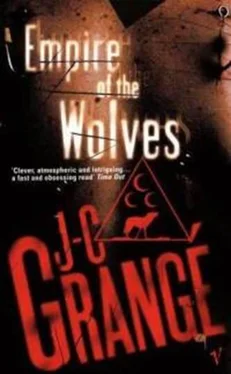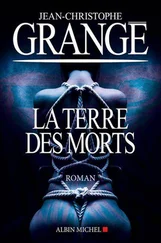Dazed, Paul listened. He could see no connection between this ancient history and his investigation. He finally asked, "And you're telling me that it's these men who are killing the women?"
"The Adidas jacket saw them taking Ruya Berkes away"
"He saw their faces?"
"They were wearing hoods, in commando getup."
"Commando getup?"
The Cipher sneered. "They're warriors, son. Soldiers. They drove off in a black station wagon. The Turk couldn't remember its registration number, or even its make. Or doesn't want to remember."
"Why is he sure that it was the Grey Wolves?"
"They shouted slogans. They have their own distinctive signs. There's no doubt about it. What's more, it fits in with the rest of the situation. The silence of the community. The fact that Gozar mentioned 'something political.' The Grey Wolves are in Paris. The Turkish quarter is shitting bricks."
Paul could not accept such a different, unexpected direction, which broke entirely with his own intuitions. He had worked too long on the idea of an isolated killer. He insisted: "But why such violence?"
Schiffer continued up the tracks, which were gleaming in the mist.
"They come from distant lands. The plains, deserts and mountains, where such torture is standard. You were working on the hypothesis of a serial killer. With Scarbon, you thought you could recognize a quest for suffering in the wounds of the victims, or the traces of some trauma or something… But you overlooked an extremely simple solution. These women were tortured by professionals. Experts trained in the camps of Anatolia."
"What about the mutilations after death? The cuts on their faces?"
The Cipher's weary gesture seemed to accept all forms of cruelty. "One of them is maybe even nuttier than the rest. Or else perhaps they don't want their victims to be recognized, for the face they're looking for to be identified."
"That they're looking for?"
The cop stopped and turned around toward Paul.
"You still don't understand what's going on, son? The Grey Wolves have a contract. They're looking for a woman." He rummaged through his bloodstained raincoat and then showed him the snapshots. "A woman with this face, answering to this description: a redhead, a seamstress, illegal alien, originally from Gaziantep."
Paul silently looked at the photos in that wrinkled hand.
Everything was taking shape. Burning up.
"A woman who knows something that they need to drag out of her. On three occasions, they thought they'd got her. And they were wrong each time."
"Why are you so sure? How can we be certain that they haven't found her?"
"Because if one of them had been their target, then she would have talked, you can be sure of that, and they would have gone."
"So… so you think the hunt's still on?"
"For sure."
Schiffer's irises were glistening below his lowered eyelids. Paul thought of silver bullets, which alone can kill werewolves.
"You got the wrong lead, son. You were looking for a killer. You were grieving the dead. But it's a living woman you need to find. Someone very much alive, who is being hunted by the Grey Wolves."
He gestured around at the buildings alongside the rail tracks.
"She's there, somewhere, in this neighborhood. In the cellars. In the attics. In the depths of a squatters' building or home. She's being pursued by the worst killers imaginable, and you alone can save her. But you're going to have to act quickly. Very very quickly. Because those bastards are highly trained, and every door in the quarter is open to them."
The Cipher grabbed Paul by his shoulders and stared intensely at him. "As they say, it never rains but it pours. I've got another piece of good news for you: if you want to pull it off, I'm the only chance you've got."
The telephone bell exploded into his ears.
"Yes?"
No answer. Eric Ackermann slowly hung up, then looked at his watch: 3:00 PM. The twelfth anonymous call since yesterday. The last time he had heard a human voice was the previous morning when Laurent Heymes had called to tell him that Anna had escaped. When he had tried to phone Laurent back later that afternoon, he'd answered at none of his numbers. Was it already too late for Laurent?
He had tried other contacts. In vain.
That evening, he had received the first anonymous call. At once, he checked through his window. Two police officers were posted in front of his building, on Avenue Trudaine. So the situation was clear. He was no longer someone to be contacted, or a partner to be kept informed. He was now someone to be watched, an enemy to be controlled. In the space of a few hours, a boundary had shifted beneath his feet. He was now on the wrong side of it, on the side of those responsible for the disaster.
He stood up and went to his bedroom window. The two policemen were still stationed outside Lycée Jacques-Decourt. He stared at the grass borders that ran along the middle of the entire avenue, the plane trees swaying, still bare, in the sunlight, the gray structures of the kiosk on Square d'Anvers. Not a single car passed, and the street looked, as usual, like a forgotten byway.
A quotation came to his mind: "Distress is physical if the danger is concrete, psychological if it is instinctual." Who had written that? Freud? Jung? How was danger going to manifest itself in his case? Were they going to shoot him down in the street? Jump him as he slept? Or just lock him up in a military prison? Torture him in order to obtain all the documents concerning the program?
Wait. He had to wait till nightfall before he could put his plan into action.
Still standing by the window, he, mentally went over the career that had brought him here, to death's antechamber.
Fear had been at the beginning. And fear would be at the end.
***
His odyssey had started in. June 1985, when he had joined Professor Wayne C. Drevets's team at Washington University in St. Louis, Missouri. The scientists had given themselves an ambitious objective: to localize the zone in the brain that caused fear, using positron emission tomography. To do so, they had drawn up a very strict protocol of experiments, which aimed to create terror in their voluntary guinea pigs. The appearance of snakes, the promise of an electric shock, which would seem all the worse the longer the wait…
After several series of tests, they had located this mysterious area. It was in the temporal lobe, at the edge of the limbic circuit, in a little region called the amygdala, a kind of niche that is the "basic brain." It is the oldest part of the organism-the one humankind shares with the reptiles-that also houses sexual instinct and aggression.
Ackermann remembered those thrilling days. For the first time, he was observing on a computer screen cerebral zones just as they were being activated. He knew that he had now found his career and his path forward. The positron camera would be the ship allowing him to voyage through the human cortex.
He became a pioneer, a cartographer of the brain.
When he returned to France, he had applied for funding from such public bodies as Institut National de la Santé et de la Recherche Médicale (INSERM); the Centre National de la Recherche Scientifique (CNRS), the Ecole des Hautes Etudes en Sciences Sociales (EHESS), as well as various universities and hospitals in Paris, thus increasing his chances of receiving a budget.
A year went by without any answers. He went into exile in Great Britain, where he joined Professor Anthony Jones's department at the University of Manchester. With this fresh team, they set out for a different neuronal region-the one governing pain.
Once again, he helped conduct a series of tests on subjects willing to undergo painful stimuli. And once again, he saw a new region lighting up on the screens: the land of suffering. It was not a concentrated region but a set of points that were activated simultaneously. A sort of spider-web running all through the cortex.
Читать дальше












